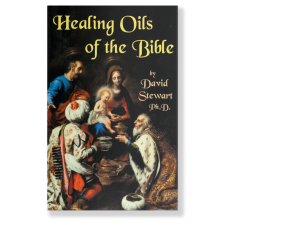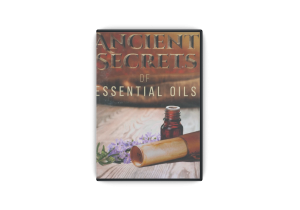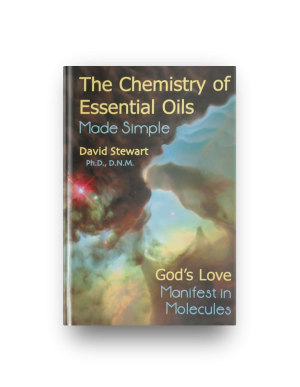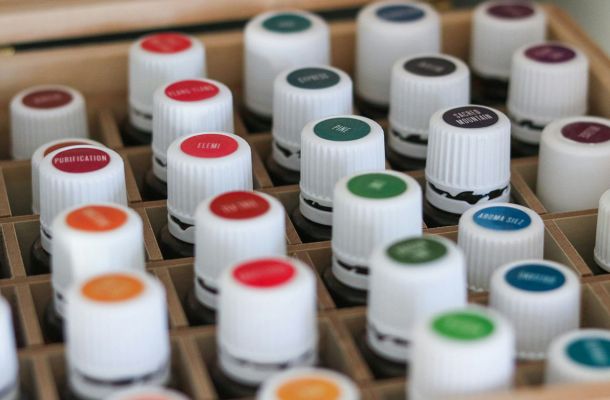When is Organic Organic? And Natural Natural? – Volume 2, Number 5
Please feel free to share this newsletter!

Raindrop Messenger
Official Newsletter of CARE
The Center for Aromatherapy Research and Education
12923 BCR 800, Marble Hill, Missouri USA 63764
(573) 238-4846
NOTE: The information in this newsletter is intended for education purposes only. It is not provided in order to diagnose, prescribe, or treat any disease, illness, or injured condition of the body or mind. Anyone suffering from any disease, illness, or injury should consult with a physician or other appropriate licensed health care professional.
A Rose is a Rose is a Rose
By David Stewart, PH.D., R.A.
Originally Posted July/August 2004
The science of essential oils falls within the realm of organic chemistry, a specialty of the broader field of general chemistry.
While organic chemistry was originally supposed to be the study of the compounds of life, it was not long before scientists came to realize that carbon was the basis of all compounds created by living processes. Hence, today organic chemistry is defined as “the study of carbon compounds.” This puts a whole new twist on the field, since today we have thousands of carbon compounds created in laboratories, synthesized outside of the natural processes of living organisms—yet they are called “organic.”
Now that scientists call all carbon compounds “organic” regardless of their origin, this poses a terminology problem for the public. For example, all petrochemicals (substances derived from petroleum) are carbon compounds. This means that pesticides, herbicides, fungicides, motor fuels, industrial solvents, pharmaceuticals, paints, disinfectants, cleaning fluids, plastics, styrofoam, antifreeze, and thousands of other toxic products that define modern living can be called “organic” since virtually all of them are composed of carbon-based molecules.
Carbon is the most versatile of all the elements and the only one capable of forming long chains and complex ring structures with itself. Its versatility makes it not only ideal as a building material for innumerable living forms, as well as essential oils, it is also ideal for creating innumerable industrial products.
However, this is not what you are thinking when you see the word organic on a package label. As a member of the consuming public, you would normally assume that the designation organic means the product (or its ingredients) were produced free of herbicides, pesticides, chemical fertilizers, hormones, antiobiotics, etc. But to an organic chemist, the term means only that the product contains carbon compounds, most or all of which could be synthetic. To a chemist, the term does not necessarily mean that no petrochemicals or pharmaceuticals were absent from their production. Fortunatly, some states have laws about the misuse of the term and have legally defined the phrase Certified Organic to mean what most consumers think it should mean.
When Does Natural Mean Natural?
To the public, the term “organic” also implies that the product was grown in healthy soil under sunlight with access to a clean atmosphere— not synthesized indoors in a lab. In other words, a product labeled as organic is also assumed to be natural, which is to say that it was grown in some fashion, not engineered in a factory on a chemical assembly line. However, in today’s competitive market, even the word “natural” is abused.
The U.S. Federal government permits the word “natural” to be used on a label if the product consists of compounds that can be produced by nature even though the content of that particular product may have been produced entirely in a chemical factory. They equate the product of a natural living plant with that of a human manufacturing plant. (They both come from plants. Right?)
If chemistry completely described the therapeutic and/or nutritional properties of a substance, this might be valid. But it doesn’t. There is a vitality and a life force in the compounds produced by living processes that are absent from those produced in a dead environment like a drug lab or a pharmaceutical plant. This is crucially important when it comes to essential oils that are intended to be used for healing.
There are thousands of examples of products labeled as containing natural ingredients when, in fact, their tastes are totally manufactured in a lab. One of the most common examples has to do with fruit flavors in drinks, candies, chewable vitamins, and other products. Most fruit flavors are formed from combinations of esters, a class of chemical compounds found in most essential oils and discussed in Chapter Ten of this book. Thus, the taste of bananas, watermelon, cantelope, peach, blueberry, raspberry, apple, orange, lime, papaya, kiwi, and just about any fruit can be imitated by assembling the right esters. Methyl anthranilate is an ester found in minor amounts in many essential oils which is also a natural compound in grapes and cherries. Synthetic methyl anthranilate is frequently used to produce beverages and confections, combined with a little color, and labeled as a grape or cherry product containing natural flavorings.
Now you know what the terms organic and natural mean on most product labels and it probably isn’t what you thought they meant or hoped they meant. Knowledge is power. Use it.
NOTE: The extract above is from Dr. Stewart’s new book
to be released in the Late Fall of 2004. It is entitled The Chemistry of Essential Oils Made Simple and its subtitle is God’s Love Manifest in Molecules. 625 pages, its price will be $34.95
OILS AND ANIMALS
by D. Gary Young, N.D.
I have raised animals all my life and presently have several miniature horses as well as four teams of draft horses. I also have pygmy goats, Barbados sheep and llamas at my ranch where I reside. On my 1300 acre herb farm at Whispering Springs in Mona, Utah, I have an animal petting zoo with Bactrian camels. zeeboos from Africa(miniature Brahmas), Watusi cows and bulls, Walleroos(miniature kangaroos), llamas, buffalos, miniature donkeys, as well as horses and goats. As you can see we have a wide variety of animals.
We have used the oils extensively on many of the animals and are continually making discoveries. The animals respond extremely well and we feel they have benefited greatly. In my experience, I have found that animals respond to essential oils much the same as humans. Animals are not as sensitive to the phenol and sesquiterpene constituents so they can be applied “neet” or full strength. One needs only to determine which oils are applicable to the situation and then apply a few drops 3-4 times daily.
Where and How Much to Apply
The amount for small animals, like cats and dogs is like the application for a child: 3-4 drops each time applied. For larger animals, like large dogs apply 6-7 drops, for horses, apply 15-20 drops.
After applying the oils, I have found it beneficial to cover the open wound with Rose ointment, which keeps the skin soft and helps promote the healing. I have applied the oils in the following ways.
- Apply on their paws where absorption is very fast.
- On cloven hoofed animals, apply on the auricular points of the ears and/or spine or both.
- Underneath the top lip on the gums and on the tongue.
- Sprinkle a few drops on the spine and then massage into the skin, just like with humans.
Conditions and Oils Applied
For various problems I have experimented with the following oils and herbal/mineral products:
- Strangle in horses, I used a combination of the oil blends Exodus II and Melrose together.(4 parts Exodus II to 1 part Melrose.)
- Ear mites in cats and dogs – purification and peppermint.
- Ticks and fleas – Tansy and tansy floral water.
- Tumors- all animals – Frankincense and lavender mixed together, frankincense and clove mixed together.
- Worms and parasites- all animals – Parafree and Di-tone.
- Open wounds- all animals -Melrose, Helichrysum and gentle care Rose Ointment.
- Trauma- all animals – Trauma Life, Valor, Peace & calming, Melissa, rosewood, lavender, valerian, and chamomile.
- Bones- all animals – PanAway, birch or wintergreen, lemongrass and spruce.
- Nervous anxiety with horses – Valor, Trauma Life, geranium, lavender and valerian.
- Saddle sores- Melrose and Rose ointment.
- Mineral deficiencies- Mineral Essence( liquid tincture, taken internally) may help meet the animals needs and when met, they will quit chewing on the furniture and engaging in other undesirable activities.
- Tissue repair and healing directly on wound – Melrose.
- May help with pain and stop bleeding – Helichrysum.
- Healing of wounds and abrasions – Rose Ointment.
Dr. D. Gary Young is President and Founder of Young Living Essential Oils, Inc. and author of several books including Essential Oils Integrative Medical Guide, available from CARE at http://www.RaindropTraining.com The above article was first published November 7, 1997
THE RAINDROP MESSENGER
Official Newsletter of CARE
The Center for Aromatherapy Research and Education
12923 BCR 800, Marble Hill, Missouri USA 63764
(573) 238-4846
NOTE: The information in this newsletter is intended for education purposes only. It is not provided in order to diagnose, prescribe, or treat any disease, illness, or injured condition of the body or mind. Anyone suffering from any disease, illness, or injury should consult with a physician or other appropriate licensed health care professional.
The Care Calendar
Topics covered in the Raindrop Messenger:
- 10 Reasons to Learn Raindrop
- 3 1/2 Day Intensive
- 3 Day Intensive
- Acid Reflux
- Advanced Chemistry of Essential Oils
- Advanced Emotional Release
- AFNOR
- Allergy Season
- Allopathy
- ALOES/SANDALWOOD
- and Emotional Release
- Annual CCI Summit
- Anointing
- Anointing with Oil & Laying on of Hands
- Applied Vitaflex
- Aroma Life
- Aromatherapist
- Aromatherapy
- Aromatherapy Certification
- Arthritis
- Believer
- BIBLE OILS
- Biblical Oils
- Birch Oil
- Black Widow
- Blue Chamomile
- Blue Spruce
- Body Systems
- cancer
- CARE Chemistry
- CARE Classes
- CARE Instructors
- CARE INTENSIVES
- CARE Seminars
- CARE training
- Carvacrol
- CCI Certification
- CCI Summit
- CCI Summit 2024
- CEDARWOOD
- Center for Aromatherapy Research and Education
- Chakras
- Charging for Raindrop
- Chemistry
- Chemistry 1&2
- Chemistry of Essential Oils
- Chemistry of Essential Oils Made Simple
- Chemotypes
- cleanses
- Clover
- Connection
- Continuing Education Credit
- CYPRESS
- Dangers Of Prescription Drugs
- Detoxifiers
- Developing Gratitude
- DI GIZE
- DIAMOND
- Do All You Can
- Earthquakes
- Education
- Elderberry
- ELECTROMAGNETIC FIELD
- EM FIELD
- Emotional Release
- Emotional Release with Oils
- Energize
- ENZYMES
- Essential Oils
- ESSENTIAL OILS FOR INTUITIVE PURPOSES
- Essiac tea
- Exodus Supplement
- Feelings Kit
- Flu
- Focus
- Frankincense
- FREQUENCES
- GALBANUM
- Garlic
- Gary Young
- German Chamomile
- Ginger
- Goals
- god's love
- Gold Frankincense Myrrh
- Grand Fir
- Grapefruit
- Growth
- Habits
- Harmonies Melodies & Symphonies with Essential Oils
- Heal Your Body
- Healing
- Healing Oils Of The Bible
- Helichrysum
- HERXING
- History of Anointing Oils
- Holy Anointing Oil
- Holy Incense
- Homeopathy
- Homeostatic Intelligence
- HYSSOP
- IASP
- Institute for Energy Wellness Studies
- Integrated Aromatic Science Practitioner
- Joy
- Juniper
- laughter
- Lavender
- Lee Stewart
- Legal
- lemongrass
- linen
- Liver
- Look Ahead.
- Love
- Lyme Disease
- Mind-Body Connection
- Mint
- Myrrh
- Myrtle Oil
- NAT
- Natural
- Natural Molecules
- Neuro-Auricular Technique
- never give up
- new age
- Ningxia
- Ningxia Red
- Non-Nutritive
- Nova Vita
- Ocotea Oil
- Onycha
- ORAC SCALE
- Oregano
- Oregano oil
- Overcoming Diabetes
- patchouly
- Peruvian Chocolate
- Pest Control
- pheromones
- phosphoric acid
- Photoxicity
- Pine
- POO-ROMATHERAPY
- Practitioner
- Preparation
- Protocel
- Pure Therapeutic Grade Essential Oil
- Quantum Physics
- Raindrop
- Raindrop and Vitaflex Techniques
- Raindrop certification
- Raindrop instructors
- Raindrop Technique
- Raindrop Technique Training
- Raindrop Training
- Raindrop Without a License
- RC Blend
- Relationship
- ringing in the ears
- Rose Essential Oil
- ROSE OF SHARON/CISTUS
- Rose Oil
- Safe Insect Repellants
- scar-b-gone
- Science Of Essential Oils Made Simple
- Sensitivities to Essential Oils
- sick building syndrome
- SPIKENARD
- Stay Positive
- staying healthy
- Success
- Supervisor Training
- Synthetic Compounds
- tansy
- Tea Tree
- The Blood Brain Barrier
- the Ecuador Clinic
- THE FIRST IMPRESSION TECHNIQUE
- the Mind-Body Connection
- THE PRAYER OF JABEZ
- The Quantum Connection
- THE SLEEP TECHNIQUE
- Therapeutic Grade
- Thieves Household Cleaner
- Thieves Oil
- Thyme
- Thyme Oil
- Tinnitus
- Transformation
- Transformation Oil Blend
- Twelve Questions to Ask Those Who Invite You to Join Another Company
- unresolved emotions
- valor blend
- Vita Flex
- Vitaflex
- Vitaflex and Raindrop
- water
- Wealth and Spirituality
- Wintergreen
- Wolfberries
- Ylang Ylang
- YLEO
- Young Living business
- Young Living Essential Oils
- Young Living Oils and Products





